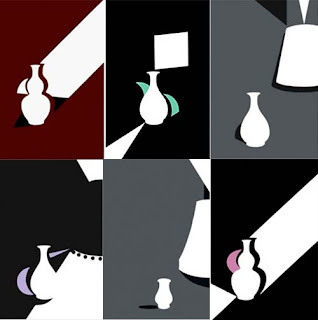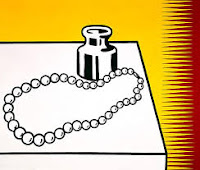Paul Caulfield (1936-2005) - London born Painter and Printmaker associated with Pop Art.
 |
| Paul Cauldfield 'White Ware' Prints |
His style was very abstract with lots of flat colour and reminds me of a cross between Roy Lichtenstein and Michael Craig Martin. Although there are many similarities it is the 'White Ware' prints that stand out as being different from the artists I just mentioned.
When I look at these pieces they in my opinion have a very lonely and peaceful feel to them. It is as if he literally cut out the objects from the canvas leaving behind a void of empty space.
Some of the white parts also represent actual light and not just the missing objects. The splashes of colour just add a little more interest which for me takes these ones to another level and make for a better piece of wall art.
The careful positioning of key parts of each composition and the perspective create subtle tension and even some depth.
I sketched a few drawings that were inspired by his style, each different from the other. I have to say I really enjoyed working in this way. I found it genuinely interesting and relaxing. Usually I like to work with music on, yet for these pieces I found myself happily in silence.
I started with the top left drawing in pencil, then switched to a fine line pen to create a more rigid line.
I had just had a cup of coffee and had left it on a case which was on the sofa. This I found a good starting point for a ready made scene. I used a 4B pencil to cross hatch in the tones and then decided to rub them in with my finger. Rather that sit thinking about it I just wanted to quickly go for it and see want happened.
Next I had a go with the lamp drawing. I started in the same way but this time I wanted to try a splash of colour. For this I used some water colours to try to achieve flatter more even colours. I made a few errors with a few of the lines but learnt a lot. If I do this again I will try to simplify it even more that I did.
My next drawing was in fine line and was another attempt at the negative drawing task for earlier in this course. For this I added some cross hatching to add some tone. Just realised I missed the shadow from the spoon on the bowl!!
These other works or art by PC again show clearly how his accurate and bold use of line to really make objects stand out. The vacant space left behind adds to each piece and in a way makes it more personal and individual for the viewer as they mentally drawn in what they think should be there.
.jpg) |
| Roy Lichtenstein |
The below and left image is one I found of PC's, and apart from not having any repeated lines or dots, could almost be one by Roy Lichtenstein. Both artists are not afraid to use space and are very confident with shape and colour.
 |
| Paul Caulfield |















.jpg)

